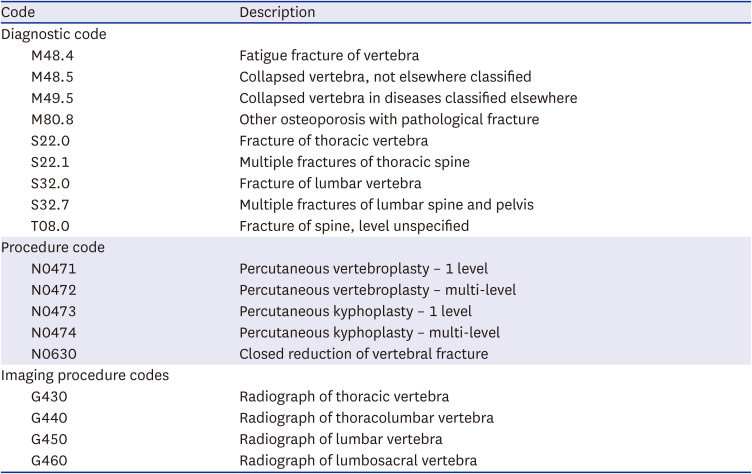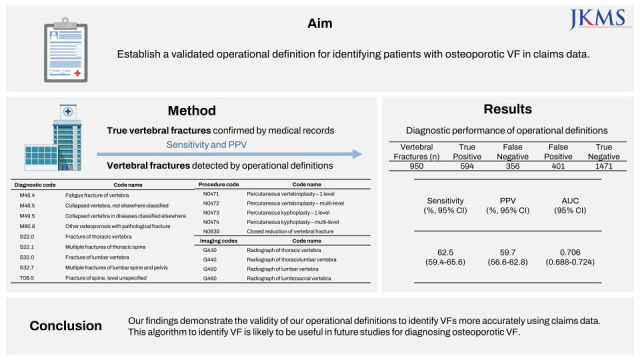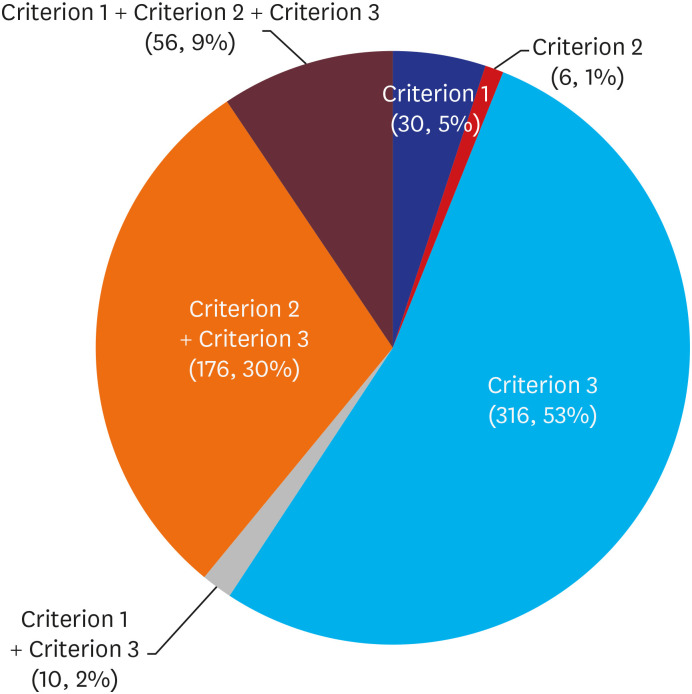1. Ballane G, Cauley JA, Luckey MM, El-Hajj Fuleihan G. Worldwide prevalence and incidence of osteoporotic vertebral fractures. Osteoporos Int. 2017; 28(5):1531–1542. PMID:
28168409.

2. Cummings SR, Melton LJ. Epidemiology and outcomes of osteoporotic fractures. Lancet. 2002; 359(9319):1761–1767. PMID:
12049882.

4. Tokeshi S, Eguchi Y, Suzuki M, Yamanaka H, Tamai H, Orita S, et al. Relationship between skeletal muscle mass, bone mineral density, and trabecular bone score in osteoporotic vertebral compression fractures. Asian Spine J. 2021; 15(3):365–372. PMID:
32872758.

5. Choi SH, Kim DY, Koo JW, Lee SG, Jeong SY, Kang CN. Incidence and management trends of osteoporotic vertebral compression fractures in South Korea: a nationwide population-based study. Asian Spine J. 2020; 14(2):220–228. PMID:
31668050.

6. Lee YK, Jang S, Jang S, Lee HJ, Park C, Ha YC, et al. Mortality after vertebral fracture in Korea: analysis of the national claim registry. Osteoporos Int. 2012; 23(7):1859–1865. PMID:
22109741.
7. Kang BJ, Lee YK, Lee KW, Won SH, Ha YC, Koo KH. Mortality after hip fractures in nonagenarians. J Bone Metab. 2012; 19(2):83–86. PMID:
24524037.

8. Lee YK, Lee YJ, Ha YC, Koo KH. Five-year relative survival of patients with osteoporotic hip fracture. J Clin Endocrinol Metab. 2014; 99(1):97–100. PMID:
24203068.

9. Jang HD, Kim EH, Lee JC, Choi SW, Kim K, Shin BJ. Current concepts in the management of osteoporotic vertebral fractures: a narrative review. Asian Spine J. 2020; 14(6):898–909. PMID:
33373513.

10. Umehara T, Inukai A, Kuwahara D, Kaneyashiki R, Kaneguchi A, Tsunematsu M, et al. Physical functions and comorbidity affecting collapse at 4 or more weeks after admission in patients with osteoporotic vertebral fractures: a prospective cohort study. Asian Spine J. 2022; 16(3):419–431. PMID:
33940771.

11. Lee YK, Kim KC, Ha YC, Koo KH. Utilization of hyaluronate and incidence of septic knee arthritis in adults: results from the Korean national claim registry. Clin Orthop Surg. 2015; 7(3):318–322. PMID:
26330953.

12. Lee S, Hwang JI, Kim Y, Yoon PW, Ahn J, Yoo JJ. Venous thromboembolism following hip and knee replacement arthroplasty in Korea: a nationwide study based on claims registry. J Korean Med Sci. 2016; 31(1):80–88. PMID:
26770042.

13. Lee YK, Ha YC, Park C, Koo KH. Trends of surgical treatment in femoral neck fracture: a nationwide study based on claim registry. J Arthroplasty. 2013; 28(10):1839–1841. PMID:
23523212.
14. Chung KC, Shauver MJ, Birkmeyer JD. Trends in the United States in the treatment of distal radial fractures in the elderly. J Bone Joint Surg Am. 2009; 91(8):1868–1873. PMID:
19651943.

15. DeNoble PH, Marshall AC, Barron OA, Catalano LW 3rd, Glickel SZ. Malpractice in distal radius fracture management: an analysis of closed claims. J Hand Surg Am. 2014; 39(8):1480–1488. PMID:
24785702.

16. Jung HS, Jang S, Chung HY, Park SY, Kim HY, Ha YC, et al. Incidence of subsequent osteoporotic fractures after distal radius fractures and mortality of the subsequent distal radius fractures: a retrospective analysis of claims data of the Korea National Health Insurance Service. Osteoporos Int. 2021; 32(2):293–299. PMID:
32876712.

17. Kakar S, Noureldin M, Van Houten HK, Mwangi R, Sangaralingham LR. Trends in the incidence and treatment of distal radius fractures in the United States in privately insured and Medicare advantage enrollees. Hand (N Y). 2022; 17(2):331–338. PMID:
32506961.

18. Kim TY, Jang S, Park CM, Lee A, Lee YK, Kim HY, et al. Trends of incidence, mortality, and future projection of spinal fractures in Korea using nationwide claims data. J Korean Med Sci. 2016; 31(5):801–805. PMID:
27134505.

19. Ha YC, Kim TY, Lee A, Lee YK, Kim HY, Kim JH, et al. Current trends and future projections of hip fracture in South Korea using nationwide claims data. Osteoporos Int. 2016; 27(8):2603–2609. PMID:
27112763.

20. Lee YK, Ha YC, Park C, Yoo JJ, Shin CS, Koo KH. Bisphosphonate use and increased incidence of subtrochanteric fracture in South Korea: results from the national claim registry. Osteoporos Int. 2013; 24(2):707–711. PMID:
22618268.

21. Lee YK, Ha YC, Choi HJ, Jang S, Park C, Lim YT, et al. Bisphosphonate use and subsequent hip fracture in South Korea. Osteoporos Int. 2013; 24(11):2887–2892. PMID:
23681088.

22. Kim HY, Ha YC, Kim TY, Cho H, Lee YK, Baek JY, et al. Healthcare costs of osteoporotic fracture in Korea: information from the National Health Insurance claims database, 2008-2011. J Bone Metab. 2017; 24(2):125–133. PMID:
28642857.

23. Kim JA, Yoon S, Kim LY, Kim DS. Towards actualizing the value potential of Korea Health Insurance Review and Assessment (HIRA) data as a resource for health research: strengths, limitations, applications, and strategies for optimal use of HIRA data. J Korean Med Sci. 2017; 32(5):718–728. PMID:
28378543.

24. Shauver MJ, Yin H, Banerjee M, Chung KC. Current and future national costs to Medicare for the treatment of distal radius fracture in the elderly. J Hand Surg Am. 2011; 36(8):1282–1287. PMID:
21705154.

25. Engels A, Reber KC, Lindlbauer I, Rapp K, Büchele G, Klenk J, et al. Osteoporotic hip fracture prediction from risk factors available in administrative claims data - a machine learning approach. PLoS One. 2020; 15(5):e0232969. PMID:
32428007.

26. Kong SH, Ahn D, Kim BR, Srinivasan K, Ram S, Kim H, et al. A novel fracture prediction model using machine learning in a community-based cohort. JBMR Plus. 2020; 4(3):e10337. PMID:
32161842.

27. Katz JN, Barrett J, Liang MH, Bacon AM, Kaplan H, Kieval RI, et al. Sensitivity and positive predictive value of Medicare part B physician claims for rheumatologic diagnoses and procedures. Arthritis Rheum. 1997; 40(9):1594–1600. PMID:
9324013.

28. Park C, Ha YC, Jang S, Jang S, Yoon HK, Lee YK. The incidence and residual lifetime risk of osteoporosis-related fractures in Korea. J Bone Miner Metab. 2011; 29(6):744–751. PMID:
21644058.

29. Lee YK, Yoon BH, Nho JH, Kim KC, Ha YC, Koo KH. National trends of surgical treatment for intertrochanteric fractures in Korea. J Korean Med Sci. 2013; 28(9):1407–1408. PMID:
24015052.

30. Cheng CL, Kao YH, Lin SJ, Lee CH, Lai ML. Validation of the National Health Insurance Research Database with ischemic stroke cases in Taiwan. Pharmacoepidemiol Drug Saf. 2011; 20(3):236–242. PMID:
21351304.

31. Cheng CL, Lee CH, Chen PS, Li YH, Lin SJ, Yang YH. Validation of acute myocardial infarction cases in the national health insurance research database in Taiwan. J Epidemiol. 2014; 24(6):500–507. PMID:
25174915.

32. De Coster C, Quan H, Finlayson A, Gao M, Halfon P, Humphries KH, et al. Identifying priorities in methodological research using ICD-9-CM and ICD-10 administrative data: report from an international consortium. BMC Health Serv Res. 2006; 6(1):77. PMID:
16776836.

33. Yoo JH, Moon SH, Ha YC, Lee DY, Gong HS, Park SY, et al. Osteoporotic fracture: 2015 position statement of the Korean Society for Bone and Mineral Research. J Bone Metab. 2015; 22(4):175–181. PMID:
26713308.

34. Lee YK, Ha YC, Yoon BH, Koo KH. Incidence of second hip fracture and compliant use of bisphosphonate. Osteoporos Int. 2013; 24(7):2099–2104. PMID:
23247329.

35. Park SM, Ahn SH, Kim HY, Jang S, Ha YC, Lee YK, et al. Incidence and mortality of subsequent vertebral fractures: analysis of claims data of the Korea National Health Insurance Service from 2007 to 2016. Spine J. 2020; 20(2):225–233. PMID:
31589928.

36. Cho SK, Sung YK, Choi CB, Kwon JM, Lee EK, Bae SC. Development of an algorithm for identifying rheumatoid arthritis in the Korean National Health Insurance claims database. Rheumatol Int. 2013; 33(12):2985–2992. PMID:
23918169.

37. Shrestha S, Dave AJ, Losina E, Katz JN. Diagnostic accuracy of administrative data algorithms in the diagnosis of osteoarthritis: a systematic review. BMC Med Inform Decis Mak. 2016; 16(1):82. PMID:
27387323.

38. Genant HK, Wu CY, van Kuijk C, Nevitt MC. Vertebral fracture assessment using a semiquantitative technique. J Bone Miner Res. 1993; 8(9):1137–1148. PMID:
8237484.

39. Curtis JR, Mudano AS, Solomon DH, Xi J, Melton ME, Saag KG. Identification and validation of vertebral compression fractures using administrative claims data. Med Care. 2009; 47(1):69–72. PMID:
19106733.

40. Lee YK, Park C, Won S, Park JW, Koo KH, Ha YC, et al. Validation of an operational definition to identify distal radius fractures in a National Health Insurance Database. J Hand Surg Am. 2021; 46(11):1026.e1–1026.e7. PMID:
33867200.

41. Park C, Jang S, Jang S, Ha YC, Lee YK, Yoon HK, et al. Identification and validation of osteoporotic hip fracture using the National Health Insurance Database. J Korean Hip Soc. 2010; 22(4):305–311.








 PDF
PDF Citation
Citation Print
Print





 XML Download
XML Download